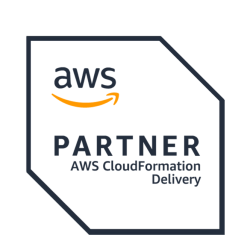As an AWS CloudFormation Service Delivery Partner, we bring:
AWS CloudFormation is an Infrastructure as Code (IaC) service that allows users to model, provision, and manage AWS resources in an automated and consistent manner. By using CloudFormation templates, organizations can define their cloud infrastructure in a declarative way, ensuring efficient and repeatable deployments.
Scenario: A software development company needs to provision and manage multi-tier applications across development, testing, and production environments.
Scenario: A DevOps team wants to automate infrastructure provisioning as part of their CI/CD pipeline.
Benefit: Ensures fast, repeatable, and reliable software releases without manual intervention.
Scenario: A global enterprise needs to maintain identical AWS environments across multiple accounts and regions for regulatory compliance.
Solution: CloudFormation StackSets allow administrators to:
Scenario: A financial services company requires a disaster recovery (DR) strategy with rapid infrastructure restoration.
Solution: CloudFormation templates define:
Benefit: Ensures minimal downtime and fast recovery in case of failures, improving business continuity.
Scenario:A startup wants to build a fully serverless application with minimal operational overhead.
Solution: Using CloudFormation, they define:
Benefit: Scalable, cost-effective, and fully managed infrastructure with minimal maintenance.
Scenario: A healthcare company needs to enforce security best practices and compliance with HIPAA regulations.
Benefit: Guarantees that every deployment follows security and compliance requirements without manual configuration.
Result: Reduced infrastructure deployment time from weeks to hours by automating resource provisioning with CloudFormation.
Impact: Enabled faster feature rollouts, improving customer satisfaction and competitive advantage.
Result: Achieved 40% cost savings by implementing CloudFormation templates that optimize AWS resource allocation.
Impact: Eliminated unnecessary resource provisioning and improved budget efficiency.
Result: Used CloudFormation StackSets to deploy identical environments in five AWS regions within hours.
Impact: Enabled quick scaling and ensured compliance with regional regulations.
Result: Automated enforcement of security best practices (IAM roles, encryption, network controls) using CloudFormation templates.
Result: Implemented an automated disaster recovery plan using CloudFormation, reducing recovery time from 8 hours to 30 minutes.
Result: Used CloudFormation to deploy and manage a fully serverless backend with AWS Lambda, API Gateway, and DynamoDB.
Impact: Reduced operational overhead and scaled seamlessly to handle user growth.
Lesson: Manual infrastructure provisioning leads to inconsistencies and errors.
Learning: CloudFormation enables fully automated, repeatable deployments, reducing operational overhead and improving reliability.
Lesson: Managing cloud infrastructure through manual configurations can lead to drift and unexpected behavior.
Learning: Defining infrastructure in YAML or JSON ensures consistency across environments, making deployments predictable and maintainable.
Lesson: Infrastructure updates can introduce breaking changes if not tested properly.
Learning: Using Change Sets before applying updates helps visualize and mitigate risks, ensuring smooth infrastructure modifications.
Lesson: Security misconfigurations can expose sensitive data and compromise applications.
Learning: Implementing IAM policies, encryption, and security group configurations within CloudFormation templates enforces best practices and compliance standards (e.g., HIPAA, PCI-DSS).
Lesson: Monolithic CloudFormation templates can become complex and difficult to manage.
Learning: Breaking templates into modular stacks improves maintainability, allowing teams to scale infrastructure easily using nested stacks and StackSets.
Lesson: Expanding to new regions or AWS accounts can be time-consuming without a standardized approach.
Learning: CloudFormation StackSets enable centralized deployments, ensuring uniformity and reducing operational complexity across multiple AWS accounts and regions.
Lesson: Traditional disaster recovery plans involve lengthy manual configurations.
Learning: With CloudFormation, teams can restore infrastructure quickly using predefined templates, minimizing downtime and ensuring business continuity.
Lesson: Over time, manual changes to resources can cause discrepancies between the actual state and the intended configuration.
Learning: Drift Detection helps identify unintended changes, allowing teams to revert or correct misconfigurations proactively.



